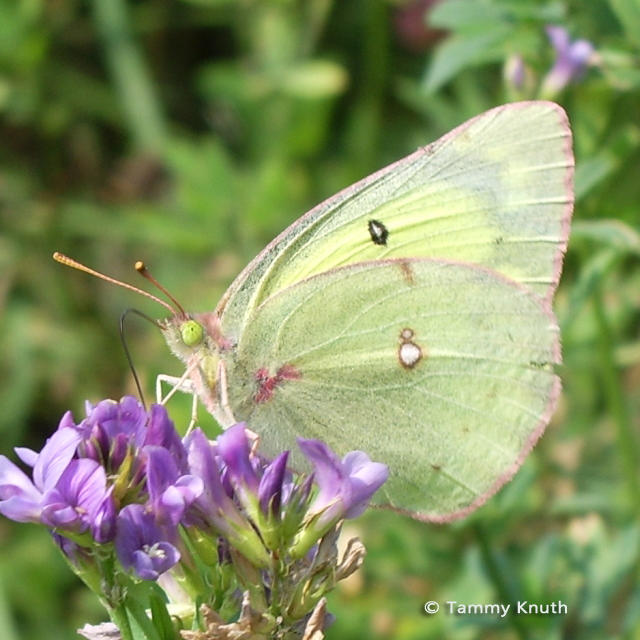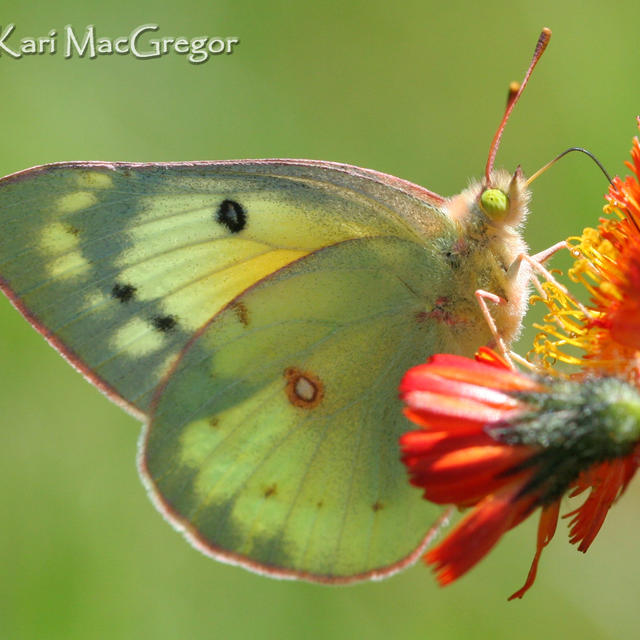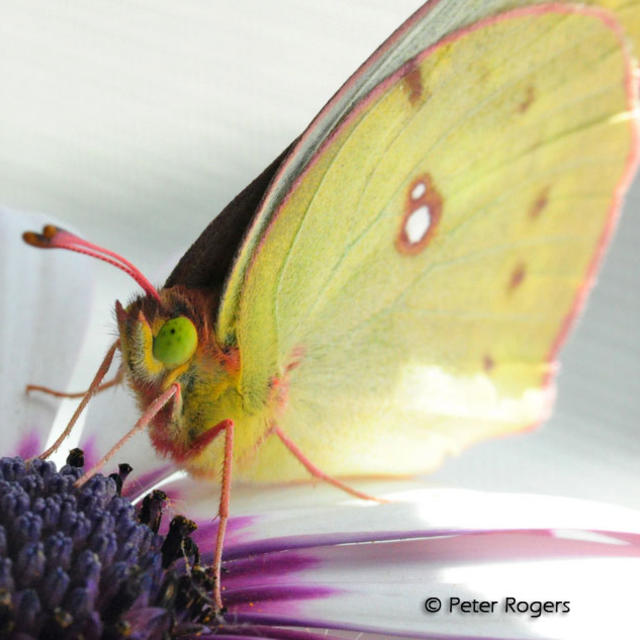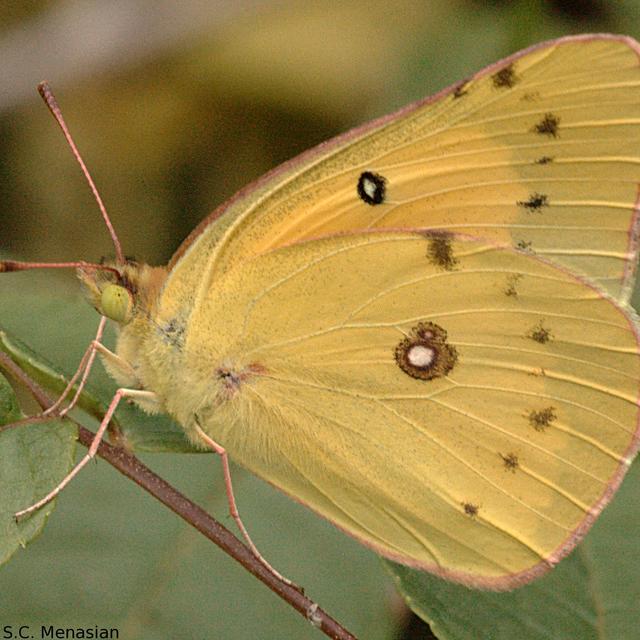Orange Sulphur
Colias eurytheme Boisduval, 1852
Family: Pieridae
Subfamily: Coliadinae
Identification: Quite variable. Upperside of male yellow with orange overlay, yellow veins, wide black border, and dark black cell spot. Female yellow or white with irregular black border surrounding light spots. Underside hindwing spot silver with 2 concentric dark rings, and a spot above it.
Wing Span: 1 3/8 - 2 3/4 inches (3.5 - 7 cm).
Life History: Males patrol for receptive females, who lay eggs singly on top of host plant leaves. Most feeding takes place at night. Young caterpillars chew holes in the tops of leaves, then later feed from the leaf tip. Older caterpillars eat half of the leaf before moving to the other half. Chrysalids overwinter.
Flight: Two-three flights in the north from June-October, 4-5 in the south from March-November.
Caterpillar Hosts: Plants in the pea family (Fabaceae) including alfalfa (Medicago sativa), white clover (Trifolium repens), and white sweet clover (Melilotus alba).
Adult Food: Nectar from many kinds of flowers including dandelion, milkweeds, goldenrods, and asters.
Habitat: A wide variety of open sites, especially clover and alfalfa fields, mowed fields, vacant lots, meadows, road edges.
Range: Southern Canada to central Mexico, coast to coast in the United States except for the Florida peninsula. Comments: One of the most widespread and common butterflies in North America.
Conservation: Not required.
NCGR: G5 - Demonstrably secure globally, though it may be quite rare in parts of its range, especially at the periphery.
Management Needs: Caterpillars can be very destructive in alfalfa fields.
Please donate!
We depend on donations to keep Butterflies and Moths of North America freely available. We want to express our gratitude to all who showed their support by making a contribution this year. You can donate to support this project at any time.
Advertise with us!
Do you have a product or service that you think would interest BAMONA users? If you would like to advertise on this website, contact us by email, or use the contact form and select the "Advertising" category.
Verified Sightings
Displaying 1 - 24 of 12939 verified sightings

Observation date: Sep 21, 2025
Submitted by: jamesvonloh
Region: Doña Ana County, New Mexico, United States
Verified by: stevecary
Verified date: Jan 13, 2026

Observation date: Dec 28, 2025
Submitted by: TJM321
Region: Texas, Williamson County, United States
Verified by: jwileyrains
Verified date: Dec 31, 2025

Observation date: Dec 18, 2025
Submitted by: Cactuswren1976
Region: Santa Fe County, New Mexico, United States
Verified by: stevecary
Verified date: Dec 19, 2025

Observation date: Dec 16, 2025
Submitted by: Cactuswren1976
Region: Santa Fe County, New Mexico, United States
Verified by: stevecary
Verified date: Dec 18, 2025

Observation date: Oct 06, 2025
Submitted by: MilissaSutton_
Region: Alameda County, California, United States
Verified by: Ken Davenport
Verified date: Nov 18, 2025

Observation date: Oct 06, 2025
Submitted by: MilissaSutton_
Region: Alameda County, California, United States
Verified by: Ken Davenport
Verified date: Nov 17, 2025

Observation date: Nov 16, 2025
Submitted by: mtobin11
Region: Lake County, Illinois, United States
Verified by: rogerdowner
Verified date: Nov 17, 2025

Observation date: Nov 11, 2025
Submitted by: sayornis_lacnm
Region: Los Alamos County, New Mexico, United States
Verified by: stevecary
Verified date: Nov 12, 2025

Observation date: Nov 08, 2025
Submitted by: BT
Region: Texas, Jones County, United States
Verified by: jwileyrains
Verified date: Nov 10, 2025

Observation date: Aug 17, 2025
Submitted by: klamke
Region: Pennington County, South Dakota, United States
Verified by: J_Martineau
Verified date: Nov 03, 2025

Observation date: Aug 26, 2025
Submitted by: sgguthart
Region: Larimer County, Colorado, United States
Verified by: mikefisher
Verified date: Nov 02, 2025

Observation date: Oct 27, 2025
Submitted by: Normsbam1
Region: Chester County, Pennsylvania, United States
Verified by: davidwright
Verified date: Oct 28, 2025

Observation date: Jul 22, 2025
Submitted by: ButterBelle
Region: Putnam County, Tennessee, United States
Verified by: CA Ivy
Verified date: Oct 24, 2025

Observation date: Aug 05, 2025
Submitted by: ButterBelle
Region: Putnam County, Tennessee, United States
Verified by: CA Ivy
Verified date: Oct 24, 2025

Observation date: Sep 12, 2025
Submitted by: Snellzy
Region: Davidson County, Tennessee, United States
Verified by: CA Ivy
Verified date: Oct 24, 2025

Observation date: Oct 14, 2025
Submitted by: mtobin11
Region: Lake County, Illinois, United States
Verified by: rogerdowner
Verified date: Oct 20, 2025

Observation date: Oct 01, 2025
Submitted by: Jes Holtz
Region: Platte County, Missouri, United States
Verified by: CA Ivy
Verified date: Oct 15, 2025

Observation date: Oct 07, 2025
Submitted by: madamirie
Region: Alameda County, California, United States
Verified by: Ken Davenport
Verified date: Oct 13, 2025

Observation date: Oct 07, 2025
Submitted by: madamirie
Region: Alameda County, California, United States
Verified by: Ken Davenport
Verified date: Oct 13, 2025

Observation date: Oct 08, 2025
Submitted by: tiki33wv
Region: Wood County, West Virginia, United States
Verified by: curtis.lehman
Verified date: Oct 08, 2025

Observation date: Oct 06, 2025
Submitted by: David Allio
Region: Fountain County, Indiana, United States
Verified by: jmgesell
Verified date: Oct 07, 2025

Observation date: Oct 01, 2025
Submitted by: Bowbender
Region: Ashland County, Ohio, United States
Verified by: rogerdowner
Verified date: Oct 04, 2025

Observation date: Sep 28, 2025
Submitted by: mtobin11
Region: Lake County, Illinois, United States
Verified by: rogerdowner
Verified date: Oct 02, 2025

Observation date: Aug 31, 2025
Submitted by: mathgeek
Region: Sandusky County, Ohio, United States
Verified by: rogerdowner
Verified date: Oct 01, 2025
- 1 of 540
- next ›


















